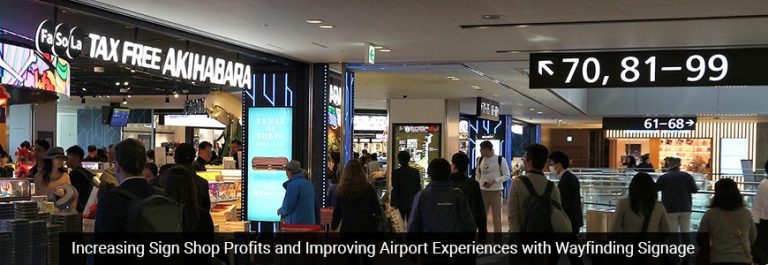Today’s post takes a look at one of the biggest users of wayfinding signage: airports.
There are signs for almost everything at airports, from fast food promotions to terminal and arrival information to slippery-when-wet warnings.
Indeed, the “airport” itself – its rules, myriad jurisdictions, spatial layout, proceduralization, and everything else – is created by signage. Fuller (2002) writes that the airport is “not explored through landmarks, it is navigated through signage” (p. 232). Without this signage, the airport would only be a confusing and potentially dangerous indoor space.
Airport signage is now “the subject of countless industry papers, forums, and technological development panels,” most of which are focused on the shift towards international standards of signage (Fuller, 2002, p. 234). Texts like the Guidelines for Airport Signing and Graphics, commissioned by the Federal Aviation Administration and initially published in 1994, are greatly influencing the way that airport systems are evolving, as well as sign shop production.
Read on to learn about this frequently overlooked signage shopper to get an idea of how profitable securing airport clientele can be, as well as what standards your airport signage needs to meet in order to keep your customers happy.
What Science Says About Essential Airport Sign Criteria:
According to the literature, airport signage has 3 primary functions:
- Direction and Orientation. Airport signage is referred to in the literature as a “spatial mode of interactivity” that “cools down the anxiety of unfamiliar terrains and replaces it with a familiar authority,” which we recognize as the traditional structures of a transit system (Fuller, 2002, p. 233-234). Put simply, we rely on airport signage to tell us where we are and how to get to our next destination. This puts travelers at ease and increases the efficiency of airports, the latter being critical in this era where privatized airports are ultimately answerable to the “bottom line” (Fuller, 2002, p. 238).
- Flow and Stability. Airport signage is crucial for organizing the airport space into “controlled flows,” which keeps people moving in a coordinated fashion that prevents crowding, confusion, and missed flights (Fuller, 2002, p. 236). To achieve this “flow function,” airport signage must be clearly presented in standardized formats, with an emphasis on concision so that’s it can be read on the go. Standardized imagery is particularly helpful in this regard.
Flow means movement, and movement produces inherent instability, which can be catastrophic at airports. Consider the consequences of “non-proceduralized” movement in this setting, such as when an operations car crosses a runway without clearance and collides with a plan, or when a passenger misses their connection because they’re sent to the wrong gate. Thus, airport signage should also promote stability; indeed, Fuller (2002) states signage is “one of the dominant technologies to stabilize the confluence of people and machines” in airport settings (p. 238). Signs create stability by displaying protocols of safety and security, identification and authorization, and licensing and unionization.
- Travel and Related Service Information. Information on departures, arrivals, baggage delivery and pick-up, government regulations (immigration, security, and customs), connecting transport, and certain special services, like car rentals, tourism, and conventions.
Learn More About Creating Airport Signage As A Signworld Business Partner
Contact a member of the Signworld business alliance to learn more about what airport clients look for and how our business alliance supports these big-ticket dealings at https://www.signworld.org.
References
Fuller, G. (2002). The arrow–directional semiotics: Wayfinding in transit. Social semiotics, 12(3), 231-244.




